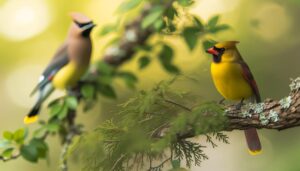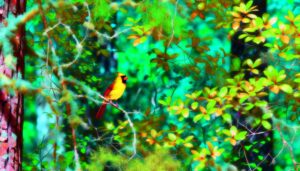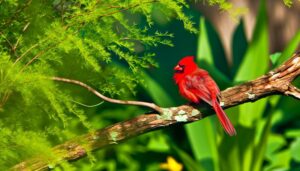Are There Yellow Cardinals in Michigan? Comprehensive Guide
Yellow cardinals, though rare, have indeed been sighted in Michigan, capturing the interest of ornithologists and bird watchers. These striking birds owe their bright yellow plumage to genetic mutations affecting pigment deposition.
Unlike the common red Northern Cardinals, these yellow variants result from altered metabolic pathways that prevent the usual red coloration. Historical sightings in the U.S., including Michigan, are sporadic but well-documented.
Identifying a yellow cardinal involves noting its unique color and black facial markings. Observers are encouraged to document sightings meticulously, enhancing scientific understanding.
There’s more to uncover about the fascinating genetics and occurrence of this rare avian phenomenon.
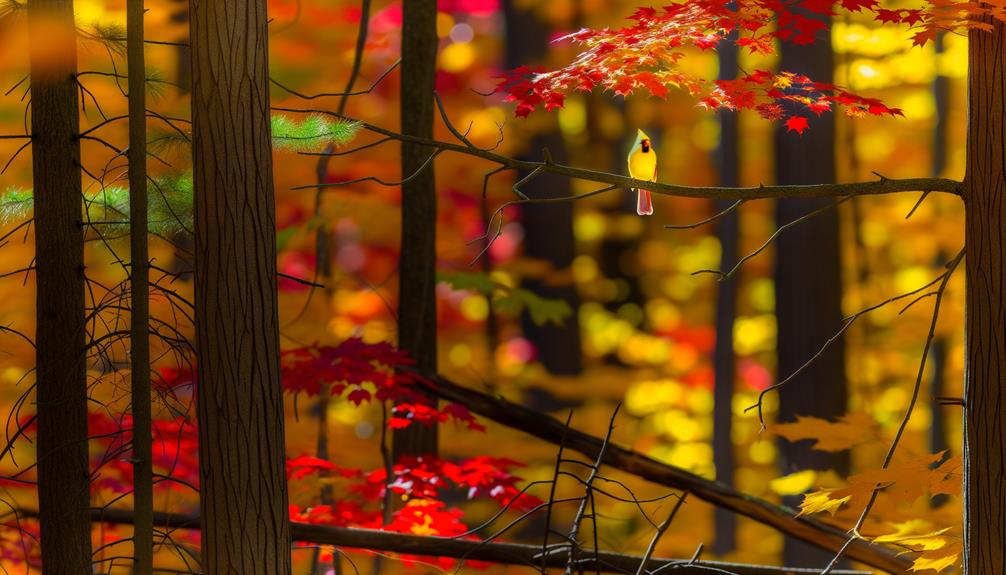
Key Takeaways
- Yellow cardinals have been documented in Michigan, although sightings are rare.
- Genetic mutations in carotenoid-processing genes cause the yellow coloration in these cardinals.
- Sightings of yellow cardinals capture significant interest from bird watchers and ornithologists.
- The yellow coloration does not impact the overall health of the cardinal.
- Detailed documentation and photographs are crucial for verifying sightings of yellow cardinals.
Yellow Cardinals in Michigan: Facts and Rarity
| Aspect | Details |
|---|---|
| Existence of Yellow Cardinals | Yellow cardinals are extremely rare but can occur due to a genetic mutation called xanthochroism. |
| Sightings in Michigan | While uncommon, yellow cardinals have been occasionally spotted in Michigan and other U.S. states. |
| Cause of Yellow Color | Xanthochroism replaces the typical red pigmentation with yellow, creating this rare coloration. |
| Rarity Level | Yellow cardinals are one-in-a-million occurrences, making sightings very rare in Michigan. |
| Similar Species | Some birds with yellow feathers may be mistaken for yellow cardinals, such as the American Goldfinch. |
Understanding Cardinal Coloration
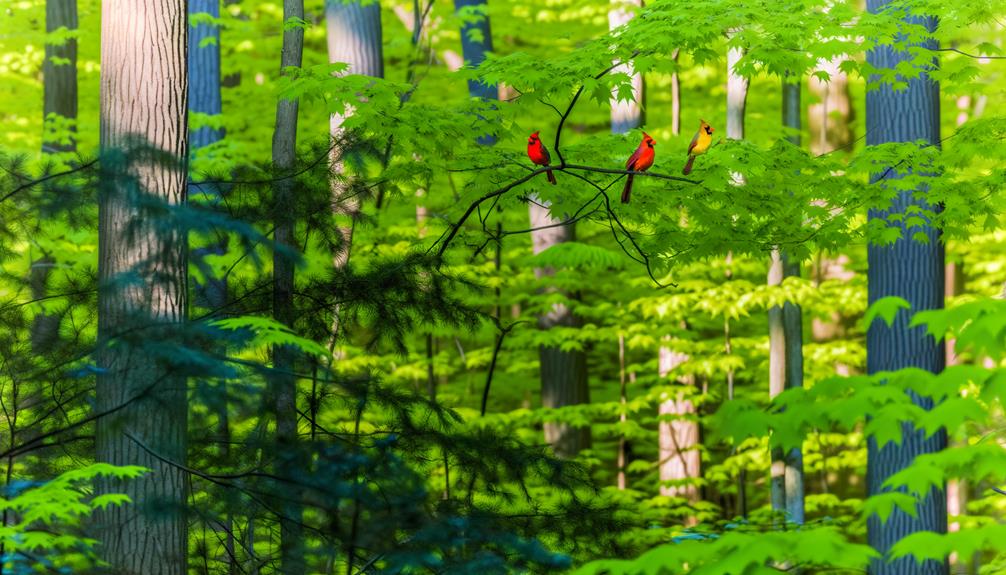
Cardinal coloration is primarily determined by the interaction of genetic factors and dietary influences.
The vivid red color commonly seen in Northern Cardinals results from carotenoid pigments found in their diet, particularly from red fruits and berries. These pigments are absorbed and then deposited in their feathers.
Genetic variations can affect the efficiency of pigment absorption and deposition, leading to differences in hue and intensity. Additionally, environmental factors such as availability of pigment-rich food sources play an important role.
The presence of specific enzymes involved in pigment conversion also contributes to the final coloration. Understanding these mechanisms provides insight into how cardinals exhibit their striking colors and adapt to their habitats.
The Yellow Cardinal Phenomenon
While the majority of Northern Cardinals display their characteristic red plumage, occasional sightings of yellow cardinals offer a fascinating deviation from the norm. This rare coloration isn’t merely an anomaly but a well-documented phenomenon that occurs sporadically within the species.
Observers often find these yellow cardinals striking due to their vibrant, golden-yellow feathers, which create a stark contrast from the typical red. The exact frequency of these sightings is difficult to determine, given their rarity and the vast geographical range of the Northern Cardinal, which spans much of North America.
However, reports of yellow cardinals have been recorded in various states, including Michigan, adding an element of unpredictability and excitement to local birdwatching endeavors.
Causes of Yellow Plumage

The yellow plumage observed in some Northern Cardinals results from genetic mutations affecting the deposition of pigments in their feathers.
Typically, cardinals display vibrant red coloration due to the presence of carotenoids, which they obtain from their diet.
However, in rare cases, a mutation alters the metabolic pathway, preventing the conversion of yellow pigments into red. This results in the feathers retaining their yellow hue.
Environmental factors, such as diet and habitat, don’t cause this coloration change but can influence the overall health and vibrancy of the feathers.
The occurrence of yellow cardinals is uncommon, making sightings of these unique birds particularly remarkable. Their striking appearance often sparks interest and curiosity among bird watchers and researchers alike.
Genetics Behind the Mutation
Mutations in the gene responsible for the production and processing of carotenoids lead to the distinctive yellow plumage seen in some Northern Cardinals. These genetic alterations affect the bird’s ability to convert dietary carotenoids into red pigments, resulting in a yellow hue.
The gene in question often involves an enzyme that modifies carotenoid molecules, and when this enzyme is deficient or non-functional, it can’t produce the typical red coloration. Researchers have identified that this mutation is rare but can occur in various populations, including those found in Michigan.
This genetic quirk doesn’t affect the cardinal’s overall health but does make these birds stand out in the wild, offering a unique glimpse into avian genetics and the variability of nature.
Historical Sightings in the U.S
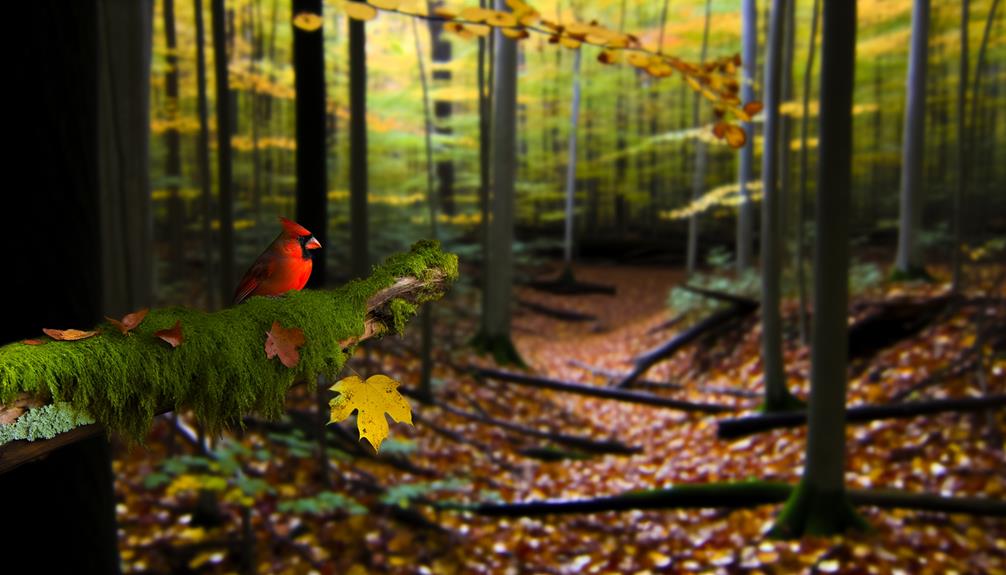
Historical records indicate that sightings of yellow cardinals in the U.S. have been sporadic but remarkable, capturing the attention of ornithologists and bird enthusiasts alike. Documented instances date back several decades, with notable sightings reported in states such as Alabama, Illinois, and Pennsylvania.
These rare occurrences often generate significant interest due to the striking contrast between the usual red plumage and the unexpected yellow hue. The phenomenon is attributed to a genetic mutation affecting feather pigmentation. Observers have meticulously recorded these sightings, noting specific locations, times, and conditions under which the birds were seen.
This data contributes to understanding the prevalence and patterns of this mutation, shedding light on the broader implications for avian genetics and diversity.
Documented Cases in Michigan
In Michigan, ornithologists have documented a number of yellow cardinal sightings, providing valuable insights into the regional prevalence and genetic basis of this rare mutation. These unusual sightings have captivated both scientists and bird enthusiasts. Each sighting is meticulously recorded, contributing to a growing dataset that helps elucidate the genetic factors responsible for the yellow pigmentation. The scarcity of these sightings underscores the rarity of this mutation.
Unexpected encounters with nature’s wonders
A beacon of hope for conservationists
Rare genetic marvels in local backyards
Inspiration for aspiring ornithologists
A reminder of nature’s unpredictability
Researchers continue to monitor these sightings, aiming to understand the environmental and hereditary influences at play. Detailed records offer a window into the complex interplay of genes and environment.
Birdwatching Hotspots in Michigan
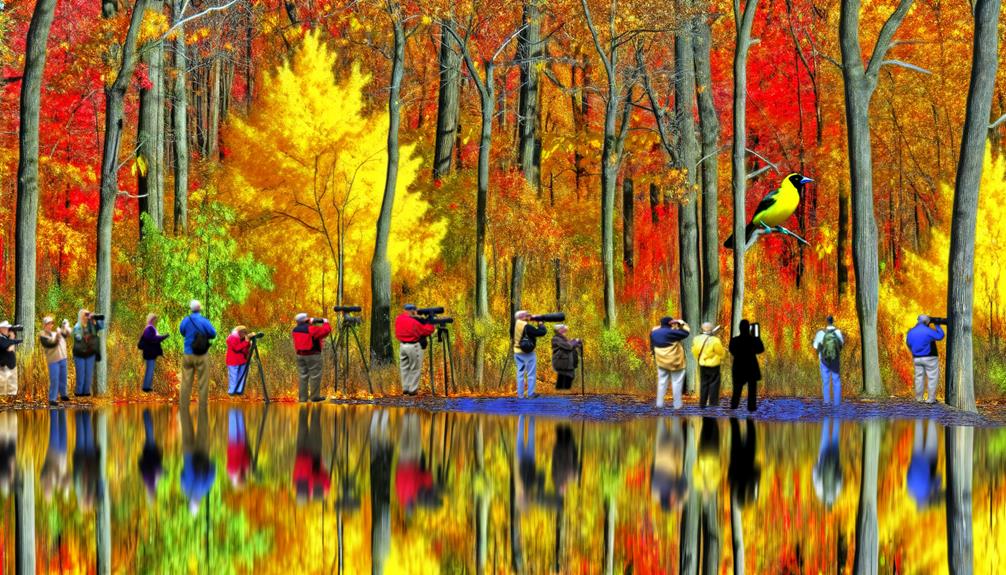
Michigan offers numerous birdwatching hotspots perfect for observing the elusive yellow cardinals, particularly in areas like the Upper Peninsula and the Huron-Manistee National Forests.
Seasonal migration patterns indicate these regions experience higher bird activity during spring and fall.
Ideal observation times coincide with these migration periods, providing enthusiasts with the best chances to spot this rare avian variant.
Best Observation Locations
Birdwatching enthusiasts seeking yellow cardinals in Michigan should consider visiting hotspots like Tawas Point State Park and Whitefish Point Bird Observatory. These locations offer prime habitats for diverse avian species, increasing the chances of spotting rare variants, such as the yellow cardinal.
Each site is renowned for its unique ecological niches that attract migratory and resident birds.
- Tawas Point State Park: Known for its diverse bird population and strategic location along migratory routes.
- Whitefish Point Bird Observatory: A critical monitoring station with a rich history of rare bird sightings.
- Sleeping Bear Dunes National Lakeshore: Offers varied terrain and rich flora attracting numerous bird species.
- Pointe Mouillee State Game Area: Wetland habitat ideal for observing a wide array of birds.
- Shiawassee National Wildlife Refuge: Extensive marshlands providing essential resources for birdlife.
These locations provide birdwatchers with unparalleled opportunities to explore and discover.
Seasonal Migration Patterns
As seasons change, avian migration patterns in Michigan reveal distinct shifts, guiding birdwatchers to best locations for spotting various species, including the elusive yellow cardinal.
During spring and fall, the state’s diverse ecosystems, such as the coastal wetlands of the Great Lakes and dense northern forests, become prime observation points. Migratory pathways concentrate near places like Pointe Mouillee State Game Area and Tawas Point State Park. These hotspots offer excellent viewing due to the convergence of various species following their migratory routes.
Winter months see a decline in migratory birds, making southern regions like Belle Isle Park more attractive for those seeking year-round residents. Understanding these patterns enhances the chances of witnessing Michigan’s rich avian biodiversity, including rare sightings.
Seasonal Movement Patterns
Researchers have documented the timing of yellow cardinals’ migration, noting distinct seasonal patterns.
Observations indicate shifts in habitat preference, with the birds favoring different environments depending on the time of year.
Climate influences these patterns, affecting both the timing and routes of migration.
Migration Timing Observations
Noting the yellow cardinals’ seasonal movement patterns, observers in Michigan have documented their migration timing with increasing accuracy. These birds exhibit a remarkable consistency in their arrival and departure times, aligning closely with seasonal changes. Researchers have identified several key observations:
- Early spring arrivals: Yellow cardinals often return by late March.
- Peak breeding season: The height of their breeding activity occurs in mid-May.
- Autumn departures: By early October, most have migrated.
- Environmental triggers: Shifts in temperature and daylight play vital roles.
- Tracking advancements: Increased use of GPS and banding methods.
Such precise data collection aids in understanding the broader dynamics of avian migration, contributing to conservation efforts and fostering a deeper appreciation for these unique birds.
Habitat Preference Shifts
Yellow cardinals display distinct changes in habitat preference throughout the year. In spring, they lean towards dense woodlands seeking cover and resources provided by thick vegetation. This habitat supports nesting and shields fledglings from predators. As the seasons progress, they shift to open fields where seeds and insects become more plentiful, aiding their dietary needs.
This change in habitat preference likely responds to both food availability and breeding requirements. During winter, yellow cardinals prefer areas with abundant shelter and food sources, such as evergreen thickets and suburban feeders. Understanding these seasonal movement patterns is vital for conservation efforts. It helps identify critical habitats that must be preserved for their survival.
Climate Influence Factors
The seasonal movement patterns of yellow cardinals are greatly influenced by climate factors, which dictate the availability of food and suitable shelter across different times of the year.
These avian species respond to temperature fluctuations and precipitation changes, often migrating to regions that offer the best living conditions.
In Michigan, the cold winters drive cardinals to seek milder climates until spring returns. This migration ensures their survival and breeding success.
- Harsh winters force them to migrate, seeking warmth.
- Spring’s return signals abundant food sources.
- Summer offers prime breeding conditions.
- Autumn triggers preparations for migration.
- Climate change alters traditional movement patterns.
Understanding these factors is vital for conservation efforts and maintaining the species’ natural freedom.
Differentiating From Similar Species
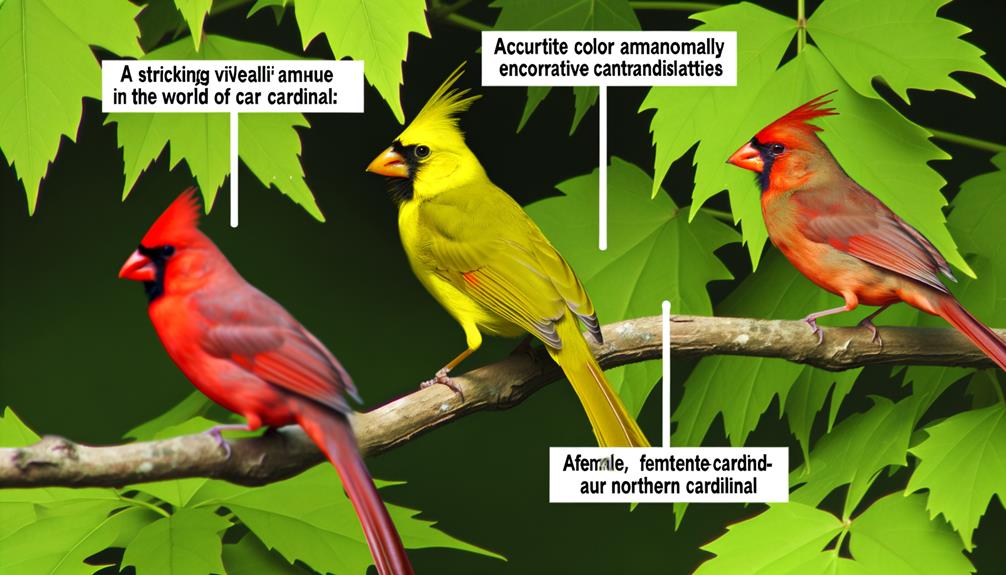
Although yellow cardinals are rare, distinguishing them from similar species like the American goldfinch and the summer tanager requires careful examination of their plumage, size, and habitat preferences.
Yellow cardinals exhibit a distinctive bright yellow plumage with black facial markings, whereas American goldfinches have a more uniform yellow body and lack the black facial mask. Summer tanagers, while also yellow, tend to be more uniformly colored and lack the cardinal’s crest.
Size differences are subtle but notable; cardinals are generally larger and more robust compared to the delicate, smaller goldfinch.
Habitat preferences also offer clues; yellow cardinals favor dense shrubs and woodland edges, contrasting with the goldfinch’s preference for open fields and meadows.
Reporting a Yellow Cardinal Sighting
When reporting a yellow cardinal sighting, observers should document the exact time and location to provide precise data for researchers.
Capturing clear photographs of the bird can help verify the sighting and aid in identification.
Additionally, contacting birding experts or local ornithological societies guarantees the information is properly recorded and analyzed.
Documenting Time and Location
Accurately documenting the time and location of a yellow cardinal sighting enhances the reliability of observational data and aids in tracking these rare occurrences. Witnesses should note the exact date and time, specifying the hour and minute, and record the precise location, including GPS coordinates if possible. Details about the habitat, weather conditions, and any unique environmental factors present at the time of the sighting are essential.
The following aspects can evoke a sense of wonder and excitement in the audience:
- A flash of yellow amidst green leaves
- The rare chance to observe a unique mutation
- Contributing to valuable scientific data
- Strengthening local birdwatching communities
- The joy of sharing a rare encounter
Such meticulous documentation safeguards the data’s scientific validity.
Photographing the Bird
Capturing photographs of a yellow cardinal provides visual evidence that complements the documented time and location, offering invaluable support to the observational data.
Photographers should use a camera with a high-resolution lens to capture detailed images. Best lighting conditions and a steady hand or tripod ensure clarity. It’s recommended to take multiple shots from different angles to capture distinguishing features like plumage coloration and markings. Using a zoom lens minimizes disturbance to the bird.
Additionally, embedding metadata in the photos, such as date and GPS coordinates, will enhance the reliability of the evidence. Sharing high-quality images with the birding community helps verify sightings and contributes to the broader understanding of this rare phenomenon.
Contacting Birding Experts
To verify the sighting of a yellow cardinal is properly documented and validated, birdwatchers should promptly contact reputable birding experts or ornithological organizations. Engaging with these authorities guarantees the rarity is accurately recorded and studied. Essential steps include providing clear photographs, precise location details, and observational notes.
To evoke excitement and prompt action, consider these steps:
- Capturing high-quality images: Enhances verification and documentation.
- Noting precise coordinates: Adds precision to the sighting record.
- Recording behavioral patterns: Offers valuable scientific insights.
- Reaching out to local birding groups: Maximizes the network of experienced observers.
- Submitting sightings to birding databases: Contributes to broader knowledge and conservation efforts.
Conservation and Protection Efforts
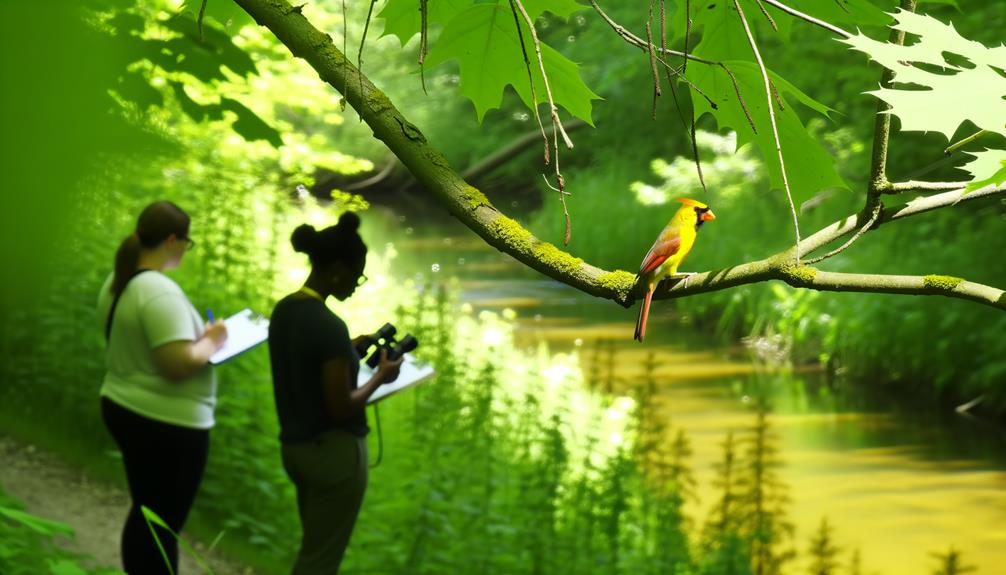
Conservationists in Michigan have implemented targeted strategies to protect the rare yellow cardinal, focusing on habitat preservation and public awareness campaigns. They’ve identified key habitats and are working to maintain and restore these areas, ensuring the cardinal’s survival.
Efforts include planting native vegetation, controlling invasive species, and improving water quality in these habitats. Public awareness campaigns aim to educate residents about the importance of biodiversity and the unique presence of the yellow cardinal. Workshops, informational brochures, and community events have been organized to foster a sense of stewardship.
Community Experiences and Stories
Residents of Michigan have shared numerous anecdotes and detailed observations, providing invaluable insights into the behavior and ecology of the rare yellow cardinal. Reports indicate sightings mainly in wooded areas, with some individuals noting unexpected appearances in urban settings. These stories often highlight the bird’s striking yellow plumage, contrasting sharply against typical red cardinals.
- Astonishment: Many observers have expressed sheer amazement upon encountering this rare bird.
- Hope: The sightings inspire hope for biodiversity in Michigan’s ecosystems.
- Curiosity: The yellow cardinal has sparked curiosity and further interest in ornithology.
- Community Bonding: Shared experiences of sightings have fostered stronger community ties.
- Conservation Awareness: Increased awareness and advocacy for bird conservation efforts have emerged.
Such community experiences underscore the yellow cardinal’s significant impact on local wildlife enthusiasts.
Conclusion
So, are there yellow cardinals in Michigan? The mystery lingers, wrapped in scientific intrigue.
While genetic mutations can lead to these rare, golden variations, sightings remain few and far between.
Historical records and community stories add layers to this enigma, urging bird enthusiasts to keep their eyes peeled.
If you’re fortunate enough to spot one, report it immediately.
The yellow cardinal’s appearance is a fleeting marvel, a proof to nature’s unpredictable beauty.




